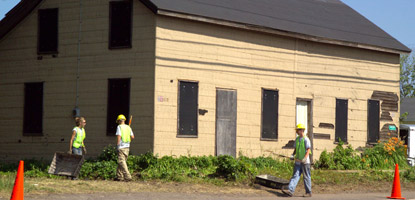|
You are viewing ARCHIVED content published online before January 20, 2025.
Please note that this content is NOT UPDATED, and links may not work. For current information,
visit https://www.nps.gov/aboutus/news/index.htm.

NPS Photo, Dan Johnson
Contact: Abby Sue Fisher, 906-337-3168 As some of the oldest homes in the Keweenaw – dating from the Civil War era – Quincy’s company houses along US-41 have important stories to tell about life in a mining town. The structures, now owned by the Quincy Mine Hoist Association, have recently been the focus of a stabilization project led by Keweenaw National Historical Park staff. Come hear Michigan Technological University graduate student Bode Morin and the National Park Service’s Steve DeLong and John Rosemurgy explain the history of these buildings and the efforts to ensure their survival.Company housing has been called the single most important element of corporate paternalism in the Copper Country. As early as the 1850s, Quincy’s managers felt that a stable and loyal workforce was vital to the company’s success, and so built many single-family dwellings to attract family men and keep them on its payroll. By 1914, the company owned 443 rental homes and provided 202 lease lots, on which workers built their own houses. Nestled in neighborhoods around the mine site, the homes became integral features of a unique mining landscape. Today, they offer the opportunity to remember the thousands of people who came here in search of a better life – one of the most fundamental themes in our nation’s history. Their importance in our national heritage was recognized in the 1980s when the Quincy mine site was declared a National Historic Landmark District. As their numbers decline, it becomes even more important to save remaining structures, particularly ones that were constructed during the Keweenaw’s early mining days. The historic resources and the industrial landscape of the former Quincy Mining Company are preserved by the Quincy Mine Hoist Association, a non profit organization formed to manage and interpret the site. The National Park Service is pleased to have partnered with the Quincy Mine Hoist Association in stabilizing these valuable resources. Bode Morin is a PhD student in MTU’s Industrial Archeology and Heritage Program, and has done extensive research on the homes as part of his graduate work. He will join Landscape Architect Steve DeLong and Historical Architect John Rosemurgy, both of Keweenaw National Historical Park, as they describe the work National Park Service crews completed over the summer. Their talk will be held at 7:00 p.m. on Thursday, September 28, at the Quincy-Franklin-Hancock Fire Station located at 49850 U.S. Highway 41, Hancock. The presentation is sponsored by Keweenaw National Historical Park’s Fourth Thursday in History program, with additional support for this event from Michigan Technological University and the Quincy-Franklin-Hancock Fire Department. The Fourth Thursday in History series arranges public presentations on important aspects of Copper Country history and techniques for historic preservation. Presentations are scheduled in venues throughout the Keweenaw Peninsula, particularly in historic sites associated with specific topics, and are free and open to the public. For further information, including specific directions to this event, contact Keweenaw National Historical Park at 906/337-3168 or check the web at www.nps.gov/kewe. Future Fourth Thursday in History Events Mining the Isle Royale Lode October 26, 2006 at 7:00 p.m. Houghton High School Auditorium 1603 Gundlach Road, Houghton, MI |
Last updated: April 10, 2015
